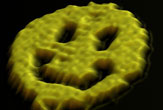
The software of life has now been woven into smiley faces, snowflakes and stars.
Caltech researcher Paul Rothemund calls his new technique "DNA origami," and he can weave any two-dimensional shape or pattern using DNA molecules. The technology could one day be used to construct tiny chemical factories or molecular electronics by attaching proteins and inorganic components to DNA circuit boards.
The research is detailed in the March 16 issue of the journal Nature.
Molecule of choice
DNA is a double-stranded, rope-like molecule used by nearly all organisms to encode the genetic instructions for proteins. It is made of four repeating chemical bases—A, T, G and C—which can be thought of as a four-letter alphabet.
A model of double helix structure of DNA with its base pairs that link in myriad ways to create the various blueprints for life as we know it. Image courtesy 3DScience.com.
The bases are complimentary, so A always pairs with T, and G pairs with C.
DNA is fast becoming the molecule of choice for nano-designers and engineers. Because of its key role in molecular biology and biotechnology, DNA's structure and chemical properties have been widely studied, and numerous tools are already available to handle it. It can also be synthesized in large quantities relatively quickly and cheaply.
Get the world’s most fascinating discoveries delivered straight to your inbox.
Mail-order origami
All of Rothemund's creations are made with a single, long DNA strand. First, the strand is folded back and forth into some desired shape or pattern. The entire structure is then fastened together at strategic points with hundreds of short DNA "staples."
Before he works with real DNA, Rothemund uses a computer to design the shapes and patterns and to determine the snippets of DNA code for the staples. He says the design program is so simple high school students could use it.
"You feed the sequence of the long DNA strand and the basic folds you want into a computer and it spits out the code for the short strands," Rothemund explained. "You send an email to a company [that synthesizes DNA] and they send you back a Fed-Ex package with the staples in it."
Self-assembling smiley faces
When heated in a salt solution, the long DNA strand and the staples come together automatically to form the desired shape.
"It self-assembles completely," Rothemund told LiveScience. "It's all designed in the computer and then it's hands off."
Each DNA staple has two arms and is shaped like a "V." Each arm is made up of a unique base sequence that binds to a complimentary sequence on the long DNA strand. Each staple binds to two different sections of the long DNA strand, bringing and keeping them together.
For example, the left arm of the staple might contain ATG and the right one CGA. When it comes into contact with the long DNA strand, the left arm will find and stick to the section containing TAC; the right arm will do the same for the sequence GCT.
In the actual experiment, each staple arm is about 13 bases long; the length of the long DNA strand is about 7,000 bases.
Nano-atlas
In the last year, Rothemund has created half a dozen shapes and patterns. Aside from stars and smiley faces, he also spelled out "DNA" and drew a rough picture of DNA's double helix shape, which resembles two intertwined ribbons. And he created a miniature map of the Western Hemisphere in which one nanometer represents about 125 miles.
A nanometer is one billionth of a meter; a human hair is roughly 100,000 nanometers wide. Rothemund's structures are typically about 100 nanometers in diameter.
Each structure required about one week to design and one week to commercially synthesize; the actual building of the structures took only a few hours. The hardest part of the experiment, Rothemund said, was taking high-resolution images of his creations, a process that took about two days each.
There is a limit to how large a structure can be, but smaller structures could be stapled together to form a large one, Rothemund said.
So far, only 2D shapes and structures have been made, but Rothemund says making 3D objects shouldn't be a problem.
For now, Rothemund's creations are little more than artwork, but he thinks scientists will one day be able to build molecular electronics by attaching things like nanowires, carbon nanotubes and gold particles onto DNA circuit boards created using his technique.
Related Stories
- Astronomers find DNA Nebula
- New 'Biological' Robots Build Themselves
- The Next X Prizes: DNA, Nanotech, Autos and Education
- New DNA Sandwich Detects Genetic Damage
- Nanotechnology May Need Regulation
More Small Stuff
- The World's Smallest Car
- The World’s Smallest Robot
- The World's Smallest Motor
- The World's Smallest Refrigerator
- Image Gallery: Micromachines


